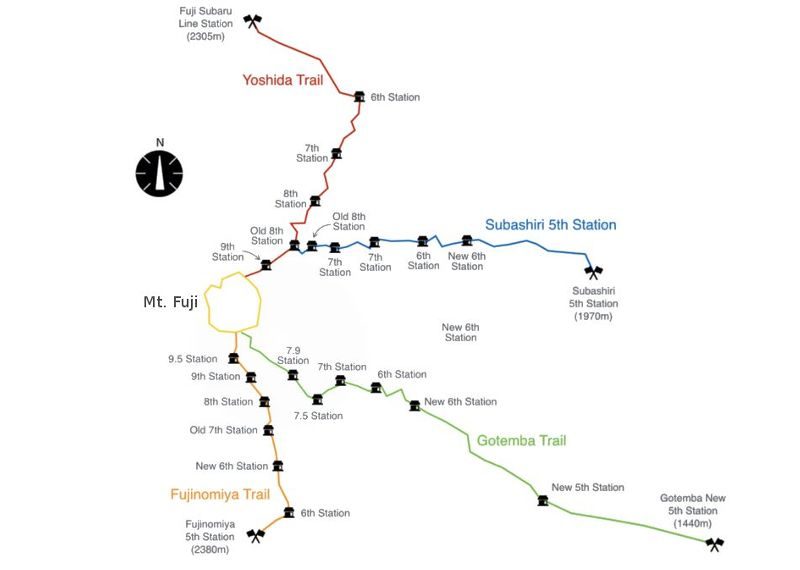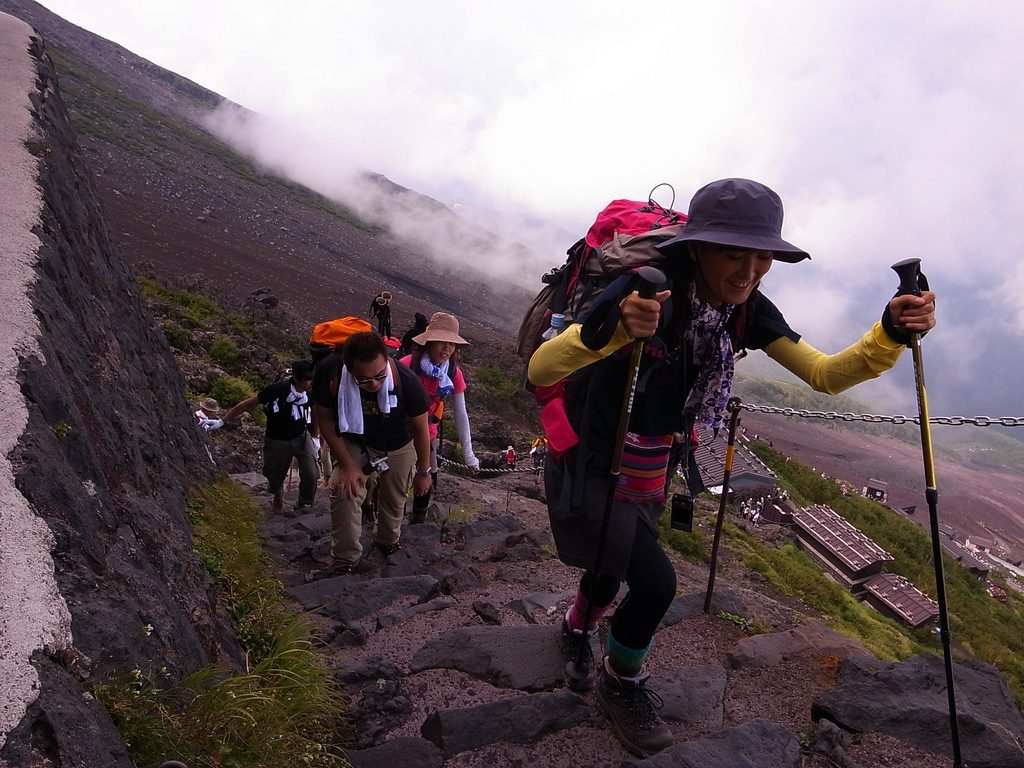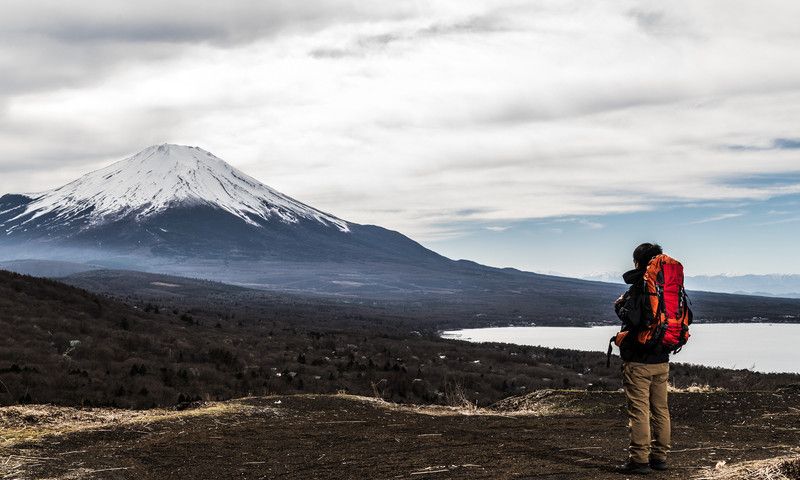Climbing Mt Fuji is on many travelers’ bucket lists. The iconic peak, which has inspired Japanese art and literature for centuries, is both Japan’s highest and most famous mountain.
The height of Mount Fuji is 12.390 feet (3776 meters) and there are different ways to climb it. There are 4 main routes which differ in difficulty and the time needed to make the journey. The views from the top combined with the sense of achievement make the trip incredibly rewarding.
Table of Contents
Mt Fuji Climbing Season
The official climbing season runs from early July to mid September. This is when the weather is mild and the mountain is usually free of snow. Visitors can easily access the mountain by public transportation and the mountain huts are open during this period.
Visitors can easily access the mountain by public transportation and the mountain huts are open during this period. It’s recommended to reserve spots in the mountain huts in advance to guarantee availability during the peak season.
Though some people make the climb outside of the climbing season, it’s more dangerous and much less accessible. Anyone with limited climbing experience shouldn’t consider climbing Mt Fuji outside of the season.
The Trails: 4 ways to go up
Mount Fuji is divided into 10 stations with the first at the bottom and the tenth at the top. There are four 5th stations which are halfway up the mountain and mark where the 4 trails start.
There are 4 trails are: the Yoshida, Fujinomiya, Subashiri, and Gotemba trails. Depending on the trail, the climb can take between 5 and 10 hours.

Yoshida Trail
This is the most popular climbing route and the most accessible. There are numerous mountain huts along the way and separate trails for the ascent and descent.
- Altitude: 2300 meters approx.
- Ascent: Up to 6 hours
- Descent: Up to 3.5 hours
Fujinomiya Trail
The Fujinomiya 5th Station is the base for the southern approach via the Fujinomiya Trail. It is easily accessible along the Tokaido Main line.
- Altitude: 2400 meters approx
- Ascent: Up to 5 hours
- Descent: Up to 2 hours and 45 minutes
Subashiri Trail
The Subashiri 5th Station is only 2000 meters above sea though it doesn’t take longer than the Yoshida and Fujinomiya trails. The Subashiri Trail meets the Yoshida Trail near the 8th station.
- Altitude: 2000 meters approx.
- Ascent: Up to 5.5 hours
- Descent: Up to 3 hours
Gotemba Trail
This is by far the lowest from the 5th station so the ascent to the top is much longer than the others. There is a group of huts at the 7th and 8th stations.
- Altitude: 1400 meters approx.
- Ascent: Up to 7.5 hours
- Descent: Up to 3 hours
How to climb Mt Fuji
Many visitors choose to climb Mt Fuji over 2 days so they can enjoy it at a more relaxing pace and take more breaks.
Climbing at a calm, steady pace is recommended and helps climbers to avoid problems such as exhaustion and altitude sickness.
Difficulty
How hard is it? The ascent to the top of Mt Fuji is relatively easy as long as you’re in good shape. There are a few challenging parts which are steep and rocky but they are not frequent.
The main challenge is the altitude which can cause climbers problems, especially those with little climbing experience.
Timing
The sunrise from Mt Fuji is spectacular and most people try to time their climb to witness it. Visibility is normally better in the early morning too.
The recommended way of doing this is to climb Mt Fuji over 2 days, resting in a mountain hut. Getting close to the top on the first day makes it easy to get to the top on the second.
Mountain huts
The Yoshida Trail has more mountain huts than the other trails. There are around 15 between the 7th and 8th stations. Overnight stays cost around 5000 yen per person without food. During peak season you should make reservations as they can be fully booked. Some mountain huts allow people to stay for short periods and charge by the hour.
Etiquette
Mt. Fuji and its foothills are recognized as a Special Place of Scenic Beauty and a Historic Site. Activities like removing plants, animals, lava, or rocks, setting up tents, and making fires are prohibited. Please be respectful.

New safety measures and charges introduced in 2024 and 2025
Due to concerns about overcrowding and safety, a series of new measures have been implemented for Mt Fuji in 2024 and 2025.
In 2024, a 2000 yen fee was introduced for climbers to hike up the Yoshida trail. As of summer 2025, this doubles to 4000 yen for all four of the main trails during the peak season between July and September. Additionally:
- Trailheads are now closed from 2pm to 3am, except for hikers in huts
- Daily limit of 4,000 hikers implemented for anyone climbing Mount Fuji
- Up to 3,000 slots can be booked online in advance, with an additional 1,000 slots reserved for same-day entries
Moreover, in response to an increasing number of people needing medical attention due to unsuitable clothing or inappropriate gear, Shizuoka prefecture has added an extra measure. Prospective climbers will have to take a brief class about hiking safety and local rules, then pass a short test to check they have understood.
You’re always advised to study each route in advance to determine which one best suits your level of physical fitness, and to plan stops to rest at appropriate altitudes.
Furthermore, inexperienced climbers are strongly advised to use the services of a mountaineering guide and to heed their advice.
Useful tips for climbing Mt Fuji
Good preparation is key to avoiding problems when climbing Mt Fuji. Having the right clothing, equipment, and supplies is recommended and visitors should respect the high altitudes. Here is some useful tips to keep in mind.
Here are some useful tips to keep in mind.
- To avoid altitude sickness: trek at a slow pace, take regular breaks, and stay hydrated. If you start to feel ill or get a headache the best thing to do is descend the mountain.
- Wear walking boots: take some good-quality walking boots and wear them in during the weeks leading up to your climb. Don’t make the mistake of buying new boots just before as they will cause blisters!
- Be ready for cold, wind, and rain: the temperature at the summit can be below zero and strong winds can make it even colder. Make sure you take clothes which protect you from the weather conditions, and check the forecast beforehand.
- Take a flashlight or headlamp: this is essential if you hike at night or very early in the morning. Headlamps are a good option as they leave both your hands free.
- Bring plenty of food and water: mountain huts offer food and drink though there are very few of them on some trails and the higher you go up, the higher the prices (so take some money just in case!). There are no bins along the trails so it’s good manners to keep all your rubbish on you until the end of your Fuji excursion.

How to get there
Mt Fuji can be approached from all sides by train, bus or car. Public transportation to Mt Fuji during the official climbing season is frequent though it’s much more limited outside of this period.
The most common routes are via Fujiyoshida, Gotemba, and Fujinomiya (all 3 are covered by the JR Pass).
Via Fujiyoshida
Visitors can get to Fujiyoshida from Tokyo by taking the JR Chuo line to Otsuki and changing to the Fujikyu line. The line takes you to Kawaguchiko where you can catch hourly buses up to the 5th Station.
You can catch the Fuji Excursion train to get to Kawaguchiko from Shinjuku Station in Tokyo.
Via Gotemba
To get to Gotemba from Tokyo, visitors can take the JR Tokaido main line to Kozu Station and then change for Gotemba. During climbing season there are direct buses to Gotemba 5th Station that take 40 minutes.
These buses are only available during the official climbing season. Visitors have the alternative of catching Suyama route buses which run all year.
Via Fujinomiya
People coming from Western Japan can take the southern approach via Fujinomiya. The Tokaido Shinkansen takes you to Shin-Fuji Station where there are regular buses during the climbing season which take you to the 5th Station.
Traveling to Mt Fuji by car
To get to Mt Fuji by car you can either take the Tomei expressway and exit at Gotemba (for the Subashiri trail) or go through to Yamanaka-ko (for the Fujiyoshida trail).
Alternatively, you can take the Chuo expressway and exit at Kawaguchi for the Fujiyoshida trail.
Please note that some no-entry dates for private vehicles have been implemented at the entrances.
This has been done to avoid congestion in the trailhead parking lots, as well as to alleviate pollution from exhaust gas. The dates may vary depending on year, but are generally during the peak climbing season.
If you’re driving to Fujinomiya and Subashiri on a no-entry date and heading to a trailhead), park in a pay lot at the foothills and take a shuttle bus or taxi to the 5th Station.
